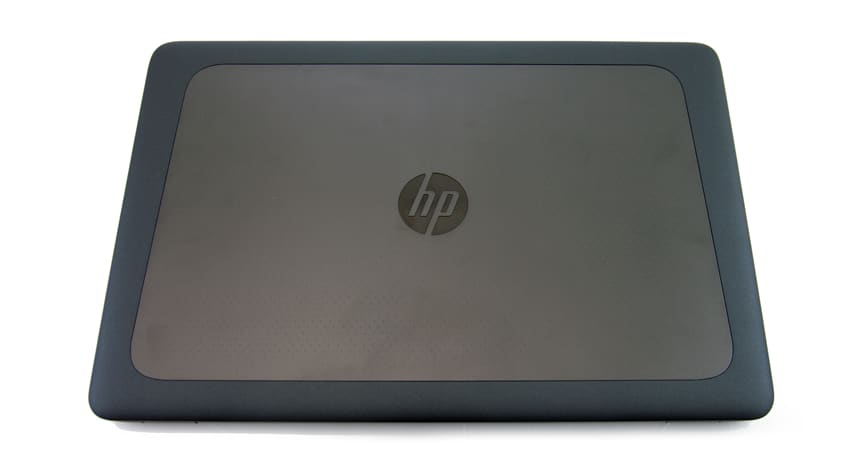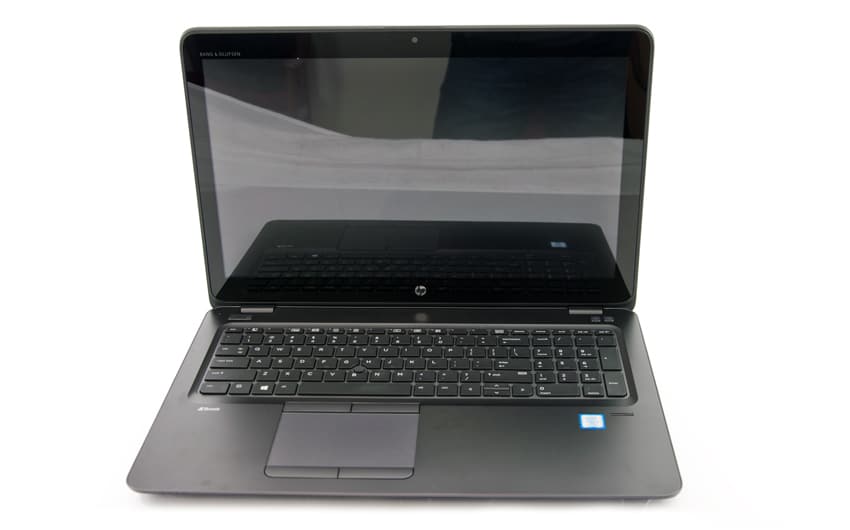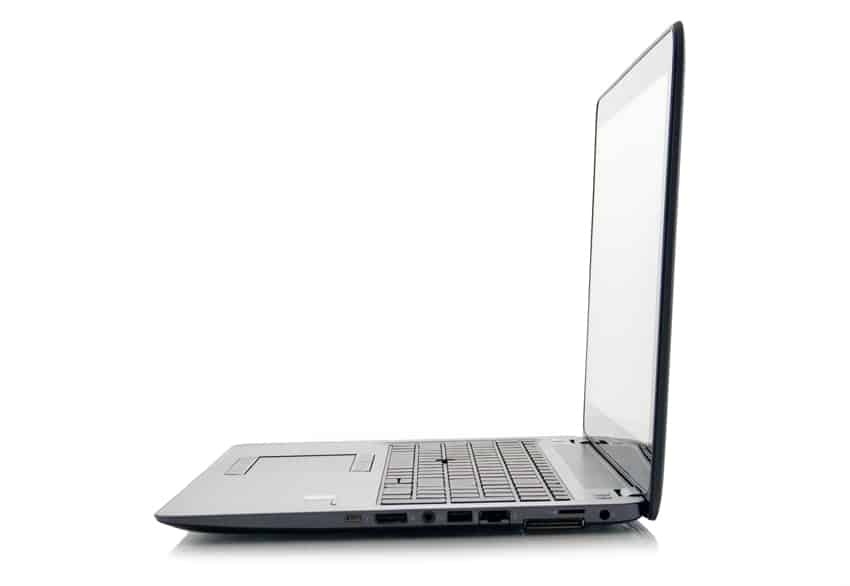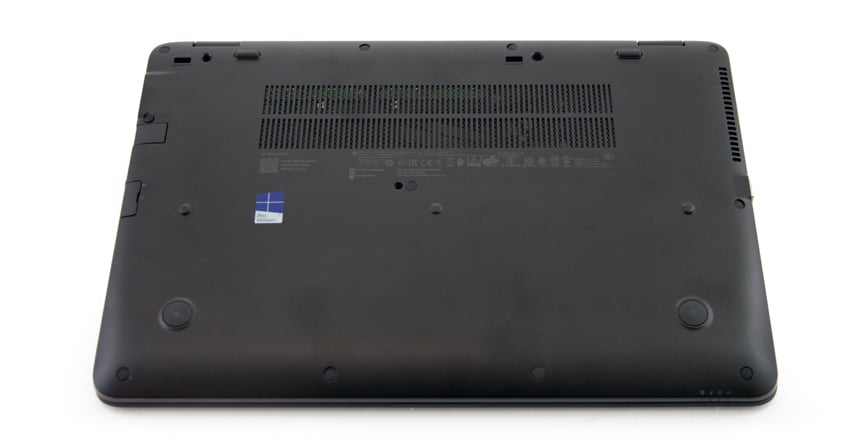
The HP ZBook 15u is a compact mobile workstation equipped with Windows 10 and the latest 7th generation Intel Core i5/i7 processors. This the 4th generation ZBook also comes equipped with three USB ports (charging, 3.1 Gen 1 and USB 3.0) a DisplayPort, and a 720p HD webcam while giving users several HD touch or a non-touch 4K UHD display options.
Though marketed as an affordable business-grade workstation (it is HP's entry-level mobile workstation), the price tag will go up for the higher-end options. This includes up to 32GB memory, AMD FirePro professional graphics card, and 1TB HP Z Turbo Drive G2. For those looking for an economical route, however, HP’s mobile workstation features a significant number of other storage options, including various M.2 and SATA drives, as well as an integrated Intel video card.
Our build includes a Windows 10 Pro 64-bit operating system equipped with a Intel Core i7-7600U CPU (2.80GHz), AMD FirePro W4190M GPU, 16GB RAM, and a Toshiba XG3 M.2 NVMe 512GB SSD. This configuration has an MSRP of $1,729, though the 15u starts at $1,079.
HP ZBook 15u Specifications
- Operating Systems:
- Windows 10 Pro 64 – HP recommends Windows 10 Pro.
- Windows 10 Home 64 for High End Devices
- FreeDOS 2.0
- Processor Family:
- 7th Generation Intel Core i5 processor
- 7th Generation Intel Core i7 processor
- Processors:
- Intel Core i7 7600U with Intel HD Graphics 620 (2.8 GHz, up to 3.9 GHz with Intel Turbo Boost Technology, 4 MB cache, 2 cores);
- Intel Core i7 7500U with Intel HD Graphics 620 (2.7 GHz, up to 3.5 GHz with Intel Turbo Boost Technology, 4 MB cache, 2 cores);
- Intel Core i5 7300U with Intel HD Graphics 620 (2.6 GHz, up to 3.5 GHz with Intel Turbo Boost Technology, 3 MB cache, 2 cores);
- Intel Core i5 7200U with Intel HD Graphics 620 (2.5 GHz, up to 3.1 GHz with Intel Turbo Boost Technology, 3 MB cache, 2 cores)
- Chipset: Chipset integrated within processor
- Memory: Up to 32 GB DDR4-2133 non-ECC SDRAM (Transfer rates up to 2133 MT/s)
- Memory Slots: 2 SODIMM
- Internal storage:
- 256GB up to 1TB HP Z Turbo Drive (M.2 NVMe PCIe SSD)
- 500GB (8 GB cache) SATA SSHD (5400 rpm)
- 256GB M.2 SATA SSD
- 512GB M.2 SATA SED SSD
- 500GB SATA (7200 rpm)
- 500GB SATA SED (7200 rpm)
- 500GB SATA SED FIPS 140-2 (7200 rpm)
- 1TB SATA (5400 rpm)
- Display options:
- 15.6-inch diagonal FHD SVA/AG (1920×1080)
- 15.6-inch diagonal FHD UWVA/AG (1920×1080)
- 15.6-inch diagonal Touch FHD SVA/AG (1920×1080)
- 15.6-inch diagonal UHD UWVA/AG (3840×2160)
- Available graphics:
- Integrated: Intel HD graphics 620
- Discrete: AMD FirePro W4190M (2GB dedicated GDDR5)
- Expansion slots:
- 1 SD media reader; 1 smart card reader
- (SD supports next generation secure digital and is backward compatible to SDHC, SDXC)
- Ports and connectors
- Left side: 1 VGA; 1 USB 3.0 (charging)
- Right side: 1 USB 3.1 Gen 1; 1 USB 3.0; 1 DisplayPort 1 stereo microphone-in/headphone-out combo; 1 power connector; 1 RJ-45
- Networking:
- LAN:
- Integrated Intel I219-LM GbE for vPro processors;
- Integrated Intel I219-V GbE for non-vPro processors
- WLAN:
- Intel Dual Band Wireless-AC 8265 802.11a/b/g/n/ac (2×2) Wi-Fi and Bluetooth 4.2 Combo; Intel Dual Band Wireless-AC 8265 802.11a/b/g/n/ac (2×2) non-vPro Wi-Fi and Bluetooth 4.2 Combo; Intel Dual Band Wireless-AC 3168 802.11ac (1×1) non-vPro Wi-Fi and Bluetooth 4.2 Combo;
- WWAN:
- HP lt4132 Qualcomm Snapdragon X5 LTE Mobile Broadband Module; HP lt4120 Qualcomm Snapdragon X5 LTE Mobile Broadband Module; HP hs3110 HSPA+ Intel Mobile Broadband Module
- LAN:
- Audio: Bang & Olufsen HD audio.
- Input device: HP Spill Resistant Keyboard (backlit with function key control); Image sensor touchpad with on/off button, two-way scroll, gestures, two pick buttons.
- Pointstick with two additional pointstick buttons.
- Camera: 720p HD webcam
- Power:
- 65 W Slim Smart AC adapter (external)
- HP Long Life 3-cell 51 WHr Li-ion
- Dimensions:
- 15.09 x 10.1 x 0.78 in
- 383.3 x 257.7 x 19.9 mm
- Weight: Starting at 4.18 lb (1.9 kg) (Weight varies by configuration and components)
- Warranty: Limited 3-year or 1-year limited warranty options available
Design and Build
The HP ZBook 15u has a starting weight of 4.18lbs with a maximum thickness of 19.9mm. Leveraging a 15.6" display area, the 15u comes with a touch screen option, which features a microphone or a dual-microphone array when equipped with the optional webcam. In addition, the keyboard has an integrated numeric keypad as well as a touchpoint interface for those who still enjoy using them over a touchpad.
The sides of the workstation house all of the workstation’s connectivity. On the right side is the USB Type-C charging port, a Dual-Mode DisplayPort for optional digital display devices, an SD memory card reader, a combo microphone-in/stereo headphone-out jack, a USB 3.x port, a space-scaling collapsing LAN port, status lights, a SIM card slot and a power connector. HP also leverages fast battery-charging technology, indicating that users can attain 50% battery life with just a 30 minute charge.
Turning the workstation around to the left side reveals the security cable slot, vents to allow for airflow to cool the internal components, an external VGA monitor port, another USB 3.X port, and a smart card reader.
Those looking to purchase the HP ZBook 15u also have the option to use the integrated GPU or the W4190M graphics card, AMD’s latest generation of FirePro mobile GPUs, depending on battery use.
Graphics Card AMD FirePro W4190M Specifications
- Form Factor: PCIe 3.0 x16
- GPU Name: Opal
- Architecture: GCN 1.0
- Process Size: 28 nm
- Transistors: 1,040 million
- Die Size: 77 mm
- Dedicated Graphics Memory: 2048 MB
- Core Clock: 825 MHz
- Memory Bus Clock: 1000 MHz
- Memory Bandwidth: 64Gb/s
- Driver Version: 21.19.142.32768
- SINGLE-PRECISION COMPUTE [GFLOPS]: 640
Performance
We put the HP ZBook 15u mobile workstation through several benchmarks to showcase its performance during resource-intensive workloads. We also examined the performance of its equipped AMD FirePro W4190M graphics card. Because ZBook 15u is an entry-business workstation, it doesn't quite add up to same power as some of the other ones we've tested recently from Dell. That’s not to say it’s a slouch when it comes to performance, as you can equip the HP mobile workstation with some pretty good hardware.
We will be comparing the HP ZBook 15u to other HP workstations: the mini, all-in-one, and desktop. It may seem a bit like comparing apples to oranges but these tests aren’t set up to show which one is “better” per se. We want to instead to illustrate the performance differential one can see in the products to help customers choose the right device for their workloads. Ultimately, we want to show what you can expect mobile version of HP’s line of workstations.
In our first test, we will look at the SPECviewperf 12 benchmark. This is the worldwide standard for measuring graphics performance based on professional applications. SPECviewperf runs 8 benchmarks it calls “viewsets,” all of which represent graphics content and behavior from actual applications. These viewsets include: CATIA, Creo, Energy, Maya, Medical, Showcase, Siemens NX, and Solidworks.
| SPECviewperf 12 | |||||
|---|---|---|---|---|---|
| Viewsets | HP ZBook 15u | HP Z1 G3 | HP z640 (M5000) | HP z640 (M2000) | HP Z2 Mini |
| catia-04 | 17.86 | 45.25 | 129.82 | 69.36 | 34.38 |
| creo-01 | 17.25 | 39.94 | 97.00 | 62.82 | 36.99 |
| energy-01 | 0.39 | 3.31 | 9.72 | 4.07 | 0.64 |
| maya-04 | 16.50 | 37.26 | 83.68 | 49.88 | 30.02 |
| medical-01 | 5.42 | 14.80 | 43.38 | 19.21 | 10.82 |
| showcase-01 | 9.76 | 22.20 | 66.68 | 28.45 | 20.40 |
| snx-02 | 19.75 | 34.80 | 118.16 | 61.94 | 28.60 |
| sw-03 | 31.96 | 78.84 | 129.69 | 91.01 | 58.56 |
The HP ZBook’s W4190M performance showed results that were in line with a lower-to-mid range mobile graphics card. The results of these viewsets include CATIA (17.86), Creo (17.25), Energy (0.39), Maya (16.50), Medical (5.42), Showcase (9.76), Siemens NX (19.75), and Solidworks (31.96). As expected, these results were well behind Z640 and Z1 workstations, as they are both equipped with higher-end cards, most notably the Z640’s NVIDIA Quadro M5000.
Along with SPECviewperf we also ran SPECwpc, a benchmark designed specifically for testing all key aspects of workstation performance. SPECwpc consists of over 30 workloads that it uses to test CPU, graphics, I/O, and memory bandwidth. The workloads fall under broader categories, such as media and entertainment, financial services, product development, energy, life sciences, and general operations, which are an average of all the individual workloads in each category. When leveraging the FirePro W4190M, the results showed 1.2 (media and entertainment), 0.58 (financial services), 1.31 (product development), 0.96 (energy), 1.14 (life sciences) and 0.99 (general operations).
| SPECwpc v2.0 | |||||
|---|---|---|---|---|---|
| Category | HP ZBook 15u | HP Z1 G3 | HP z640 (M5000) | HP z640 (M2000) | HP Z2 Mini |
| M&E | 1.2 | 2.35 | 4.34 | 3.93 | 2.37 |
| ProdDev | 1.31 | 2.01 | 4.3 | 3.83 | 2.21 |
| LifeSci | 1.14 | 2.26 | 5.58 | 4.75 | 2.29 |
| Energy | 0.96 | 2.14 | 6.14 | 5.49 | 1.79 |
| FSI | 0.58 | 1.26 | 0 | 4.82 | 1.29 |
| GeneralOps | 0.99 | 1.25 | 1.49 | 1.5 | 1.36 |
Using our ESRI benchmark, we look at several aspects of the ArcGIS program; however, we are most interested in the average of the drawtime, average frames per second (Average FPS), and minimum frames per second (Minimum FPS). Looking at drawtime, the 15u showed an average time with 00:00:24.49. Average FPS gave us 53.36 and Minimum FPS showed the 15u performing at 24.47.
| ESRI Benchmark | |
|---|---|
| Drawtime | Average |
| HP ZBook 15u | 0:00:24.489 |
| HP Z2 Mini (M620) | 0:00:04.929 |
| HP Z1 G3 | 0:00:10.746 |
| HP z640 (M5000) | 0:00:06.324 |
| HP z640 (M2000) | 0:00:06.262 |
| Average FPS | Average |
| HP ZBook 15u | 55.36 |
| HP Z2 Mini (M620) | 179.39 |
| HP Z1 G3 | 72.60 |
| HP z640 (M5000) | 286.87 |
| HP z640 (M2000) | 273.51 |
| Minimum FPS | Average |
| HP ZBook 15u | 24.47 |
| HP Z2 Mini (M620) | 97.58 |
| HP Z1 G3 | 49.35 |
| HP z640 (M5000) | 112.13 |
| HP z640 (M2000) | 160.51 |
Our last benchmark is PCMark, which is a tool that calculates the performance at the system and component level and most often represents typical home user workloads for all types of PCs, including tablets, mobile workstations, and desktops. While there are multiple categories that PCMark tests (including typical work usage, home usage, and creative usage), we will only be looking at the storage benchmark for this review.
| PCMark Storage | ||
|---|---|---|
| Score | Bandwidth | |
| HP ZBook 15u G4 | 5,017 | 358.54MB/s |
| HP Z2 Mini | 5,066 | 484MB/s |
| HP Z1 G3 | 5,093 | 636.51MB/s |
| HP z640 | 5,014 | 330.68MB/s |
The Storage PCMark tests the performance of any drives installed in the system, leveraging traces recorded from Adobe Creative Suite, Microsoft Office and a selection of more popular video games to measure real-world performance differences between storage devices. Here, the HP ZBook 15u posted a score of 5017 with a bandwidth of 358.54 MB/s using a Toshiba XG3 M.2 NVMe SSD. These results were slightly better than the HP z640 desktop solution (which leveraged two Z Turbo Drives), though it was well below the HP Z2 Mini.
Conclusion
The HP ZBook 15u is a 15” business class mobile workstation. Being an entry business workstation means that it is both more affordable but lacks the performance wallop of the other workstations such as the HP desktops we’ve reviewed. Still, the workstation offers 7th generation Intel Core i5 or i7 CPUs, up to 32GB of DDR4 2133 non-ECC memory, up to 1TB of M.2 NVMe Z Turbo drive storage, and a slew of connectivity ports for most use cases. The 15u is highly customizable as well so users can save on costs by configuring the workstation to their needs. For graphics the 15u offers an integrated and dedicated GPU option with the Intel HP graphics 620 and an AMD FirePro W4190M.
For performance we look at both our graphics-intensive benchmarks SPECviewperf, SPECwpc, and ESRI as well as the PCMark test for storage. For comparisons we look at other workstations in HP’s family. We are less interested in which one is better (the 15u is a entry-level business-grade model and won’t hold its own against the more high-end models; HP does, however, three other mobile workstations with its ZBook 17 being much more performance oriented) and more interested in demonstrating what users can expect from each model next to each other. That way, users will be able to easily select the type of workstation that best fits their needs.
On the graphics side of things the 15u performed a little less than half of the next closest in terms of performance, the Z1 all-in-one. Again it is to be expected and it not really a surprise. On the ESRI test Average FPS the 15u did hit a score of 55.36, which is not too far under the Z1’s 72.6. On the storage side of testing, the 15u scored in line with the other HP drives with a PCMark score of 5,017 and a bandwidth of 358.54MB/s, both scores were actually higher than the z640 desktop.
Pros
- Highly customizable
- Touch Screen optional
- Decent performance for a business-grade, mobile workstation
Cons
- Dedicated GPU performance leaves a bit to be desired
The Bottom Line
The HP ZBook 15u gives users on the go enough performance for a variety of tasks without breaking the bank.
Sign up for the StorageReview newsletter




